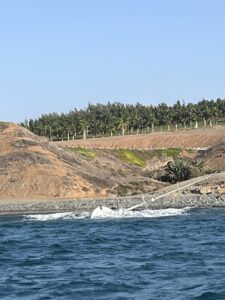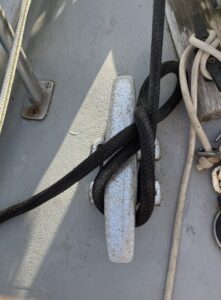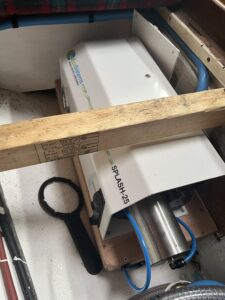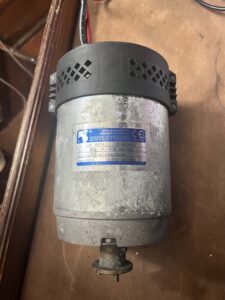
I have just spent an awfully long time sitting in the cockpit looking at the wrecked yacht on the beach. The tide is out, and half the hull is exposed. The mast moves as each wave lifts and then dumps her back on the sand with a thump.
I wonder whether the owner has “wreck removal” insurance. I have wreck removal insurance – and I might have been making a claim today…
This is a paean to the philosophy of stones in the pot. If you have read my book The Voyage (#1 BVIs to Falmouth), you will know all about stones in the pot. Briefly, the idea is to imagine that a small earthenware pot sits in the corner. Every time you do something for the good of the boat, you toss a small pebble into the pot.
The stones represent the boat’s store of good luck. Every boat needs good luck: A lucky boat will sail past the floating container, not into it. On lucky boats, shackle pins fall into the scuppers, not over the side.
And, as happened the other day, when a line catches under the cap for the chimney and removes it smoothly (because it hasn’t been used since North Wales in March and gets greased on the first of every month), the cap bounces daintily across the coachroof and comes to rest against the shrouds instead of going plop.
Now that the varnishing is done, I have moved out of the marina at Pasito Blanco. I no longer need the mains electricity to run the hot air gun. The anchorage outside is lively in a brisk easterly, but I have to wait until Monday to see whether the gas depot can fix their connector and fill my Calor cylinder. So Saturday seemed like a good day to go into town for lunch, wi-fi and a new Bluetooth speaker.
It was while I was rowing back into the marina – well, being blown there at a quite astonishing rate, that I found myself going over the anchoring arrangements, and came up short with a jolt: I had left the chain on the windlass.
You’re not supposed to do that. The windlass is not designed to take the weight of the boat for long periods – especially jolting with every wave.
Of course, she shouldn’t be jolting – there was a chain hook and a three-metre strop to take the snatch loads. But all the same – if the hook jumped off (it’s never happened). All the same…
I should go back. I should turn round and row into the fresh easterly. I would get wet. The bike would get wet (with salt water – and I hadn’t brought its little waterproof coat). Was this really necessary? I hesitated, half turned round. A wave slopped onto my knee.
Then I saw the wreck, now underwater, just her mast and the shredded furling genoa pointing at a crazy angle.
So yes, I did go back – and yes, I did get soaked. So did the bike.
But it was just as well.
It turned out that the chimney cap landing in the shrouds had emptied the pot of stones, and Samsara’sluck had run out. What did I find? Not only had I had failed to make the chain fast on the starboard cleat, but I hadn’t even checked that the strop was properly secured on the port.
And it wasn’t. It looked as though my hurried reverse turn as the foredeck bounced like a fairground ride, had missed completely. In half an hour, the whole lot would be over the side (and you can’t buy galvanised chain hooks any more).
Besides, how long would the chain have held on the gipsey with the constant snatching of the swell. I could just see it – the whole 50metres running out until it stopped with a bang at the ancient rust-stained bit of codline on the bitter end.
How long would that last as I sat in Pitos y Flautas eating spaghetti frutti di mare and downloading Leave the World Behind on Netflix?




I certainly agree with you. I twice persuaded a former employer to sell a ship on the grounds that she was unlucky. I owned two boats, for a total of forty years, which I considered lucky on the grounds that they had both sunk before I bought them and having tried it they would not do it again.